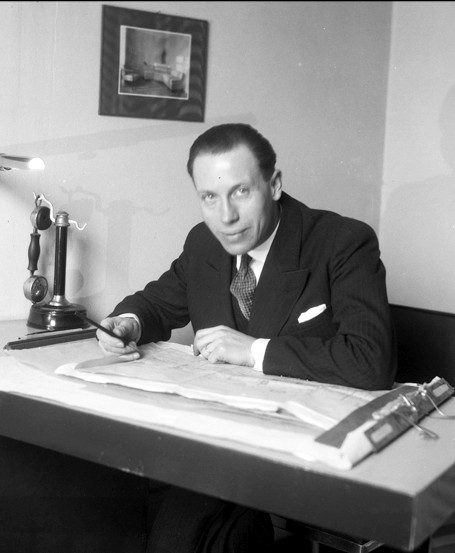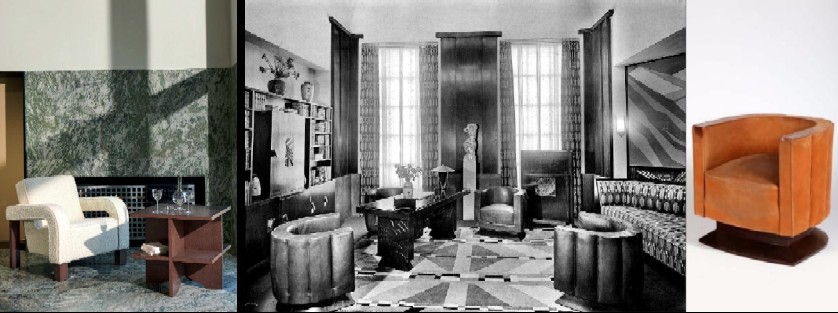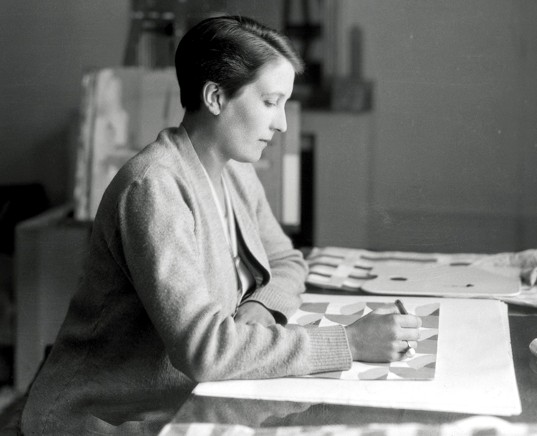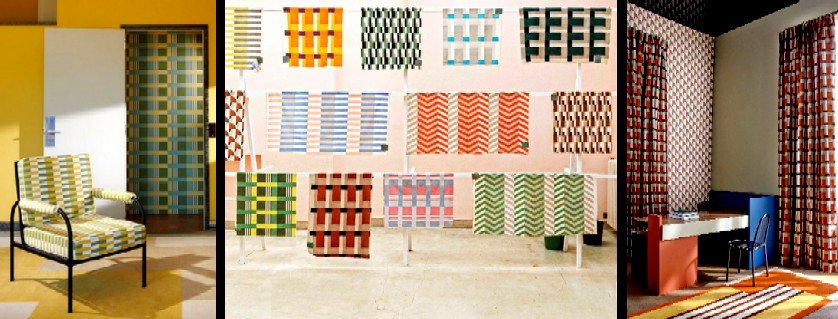
Georges (1898-1937) and Élise (1894-1986) Djo-Bourgeois
Georges and Élise Djo-Bourgeois were a French design team who were active from 1922 until Georges' death in 1937. The couple is often referred to simply by antique dealers as 'DJO-Bourgeous'. The duo had complementary talents - he was an architect and designer while she focused on textile design.
Georges was born in Bezons, France and began attending the École Spéciale d'Architecture (ESA) in 1914,

Georges and Élise Djo-Bourgeois. Pierre Frey
at age 16. He left school to enlist during World War I where he served as an engineer. After the war, her returned, graduating in 1922. "At the end of his studies, like many other architects, DJO BOURGEOIS devoted himself to the creation of furniture and interior decoration rather than architecture." (De Vos Galerie) His efforts were first displayed publicly at the 1922 Salon d'Automne. The next year, he designed a boudoir which was shown at the Salon of the Societe des Artistes Decorateurs. He continued to display at these venues throughout his career.
Impressed by Djo-Bourgeois' display at the 1924 Societe des Artistes Decorateurs Salon, noted French modernist architect Robert Mallet-Stevens invited Georges to work with him on the villa of Vicomte Charles de Noailles. Georges contributed pieces and designed the Dining Room which gave him exposure. Clients in the area saw this work and began to contract him for their projects in southeastern France.
In 1924, Georges joined the creative team at the Louvre Museum workshop, Stadium Louvre. There, he designed wooden furniture and interiors for the Grands Magasins du Louvre working with Etienne Kohlmann and Maurice Matet. He married Élise George in 1925 and the pair decided to work together. He left the Louvre that year and established his own workshop in Paris. His work become recognized through displays at French exhibits and the design work for the Vicomte's villa.
"He was attracted to innovative materials. including Terazolith composition rubber. Some of his furniture was produced with a lacquer finish. An early 1920s room setting included veneered pieces; from 1926, he used metal in his furniture, particularly aluminum with wood, and nickel-plated
steel tubing. His interests included the design of kitchens and children's rooms." (Mel Byars, The Design Encyclopedia, 1994, p. 75) Beginning in 1926, Georges stared focusing on French metal furniture; some of his designs were produced by Metz & Company. "He realized different pieces in this material, the most emblematic being a table with a circular glass top resting on a mirror cylinder joined to a nickel-plated base which the Maharadjah of Indore chose to furnish his palace in India." (De Vos) He created a dining room suite entirely from aluminum in 1929.
Georges "is known for his total commitment to modernity. His style is rigorous, minimalist. In his projects, he follows the paradigms of modern architecture: large baies [windows], simple lines, terrace and cement." He assembled simple forms such as "the cylinder, the cone, the rectangle. We find the same approach in his proposals for furniture. However, he remains attentive to the harmony of volumes [space], colors and materials. He quickly became very successful with a clientele looking for a new aesthetic in keeping with modern life." (" Elise Djo-Bourgeois: a modern woman and artist", Pierre Frey, gathered 4-29-24)
 Georges Djo-Bourgeois Furniture, From Left: Reissued Chair and Table, c. 1935, Pierre Frey; Coral Leather Armchair, 'Studium-Louvre', Grands Magasins du Louvre, Displayed at the Exposition Internationale des Arts Decoartifs, Paris, 1925
Georges Djo-Bourgeois Furniture, From Left: Reissued Chair and Table, c. 1935, Pierre Frey; Coral Leather Armchair, 'Studium-Louvre', Grands Magasins du Louvre, Displayed at the Exposition Internationale des Arts Decoartifs, Paris, 1925
Élise Djo-Bourgeois (nee George) was born in Oran in 1894.

Georges and Élise Djo-Bourgeois. Pierre Frey
She was educated in the arts in Paris, attending Académe Julian and Les Ateliers de Montparnasse. When she married Georges in 1925 she decided to display her work in fabrics, rugs and wallpapers under her married name. She worked closely with her husband, but she also sold her products through other stores and designers. She designed for Jean Royer and Maison Maurice Lauer.
Like her husband, Élise hewed strongly to modernist designs concepts incorporating the simplicity, combinations of geometric shapes and harmony into her designs. "Deliberately limiting herself to three or four colours, her compositions offer an elaborate combination of circles, rectangles, triangles and broken lines. The ever-present white marks the relationship between form and colour. The chromatic range used by the artist is subtle and wide, from pastel tones to more contrasting colour combinations. ...Elise's creations are all printed by hand with the block printing technique. This artisanal technique generates a certain irregularity in the graphic pattern, thus removing any stiffness." (Pierre Frey)
When her husband died in 1937, Élise ceased to publicly produce designs. Little seems to be known about her life after that.
Sources Not Cited Above:
Andrew Ayers, "Djo-Bourgeois, A Shooting Star", La Gazette Drouot, Gathered 4-29-24
Djo-Bourgeois. Wikipedia, Gathered 4-29-24
"Elise DJO-Bourgeois", The Baton, Gathered 4-29-24
"Pierre Frey Reissues Striking Geometric Textiles by Elise Djo-Bourgeois", Interior Design, Gathered 4-29-24
Original Facebook Group Profile
 Élise Djo-Bourgeois Fabrics, From Left: Chair and Wallpaper, Pierre Frey, Atelier Textiles; Re-Released Djo Fabrics Samples on Display, Interior Design; Window Treatments and Curtains Re-Release Collection, Pierre Frey
Élise Djo-Bourgeois Fabrics, From Left: Chair and Wallpaper, Pierre Frey, Atelier Textiles; Re-Released Djo Fabrics Samples on Display, Interior Design; Window Treatments and Curtains Re-Release Collection, Pierre Frey